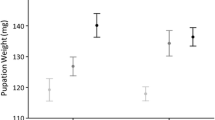Abstract
Sexual selection theory predicts that female choice may favour the evolution of elaborate male signals. Darwin also suggested that sexual selection can favour elaborate receiver structures in order to better detect sexual signals, an idea that has been largely ignored. We evaluated this unorthodox perspective by documenting the antennal lengths of male Uraba lugens Walker (Lepidoptera: Nolidae) moths that were attracted to experimentally manipulated emissions of female sex pheromone. Either one or two females were placed in field traps for the duration of their adult lives in order to create differences in the quantity of pheromone emissions from the traps. The mean antennal length of males attracted to field traps baited with a single female was longer than that of males attracted to traps baited with two females, a pattern consistent with Darwin’s prediction assuming the latter emits higher pheromone concentrations. Furthermore, younger females attracted males with longer antennae, which may reflect age-specific changes in pheromone emission. These field experiments provide the first direct evidence of an unappreciated role for sexual selection in the evolution of sexual dimorphism in moth antennae and raise the intriguing possibility that females select males with longer antennae through strategic emission of pheromones.


Similar content being viewed by others
References
Andersson M (1994) Sexual selection. Princeton University Press, New Jersey
Ashman KR, McNamara KB, Symonds MRE (2016) Experimental evolution reveals that population density does not affect moth signalling behaviour and antennal morphology. Evol Ecol 30:1009–1021. doi:10.1007/s10682-016-9857-0
Bates D, Maechler M, Bolker B, Walker S (2014) lme4: Linear mixed-effects models using Eigen and S4. R package version 11–7. URL: http://CRAN.R-project.org/package=lme4
Bernays EA, Chapman RF (1998) Phenotypic plasticity in numbers of antennal chemoreceptors in a grasshopper: effects of food. J Comp Physiol A 183:69–76. doi:10.1007/s003590050235
Berndt LA, Allen GR (2010) Biology and pest status of Uraba lugens Walker (Lepidoptera: Nolidae) in Australia and New Zealand. Aust J Entomol 49:268–277. doi:10.1111/j.1440-6055.2010.00760.x
Chapman RF (1982) Chemoreception: the significance of receptor numbers. Adv Insect Physiol 16:247–356. doi:10.1016/S0065-2806(08)60155-1
Darwin C (1871) The descent of man and selection in relation to sex. Murray, London
Faucheux MJ (1984) Morphology and distribution of antennal sensilla in the female and male clothes moth, Tineola bisselliella Humm. (Lepidoptera: Tineidae). Can J Zool 63:355–362. doi:10.1139/z85-054
Gibb AR et al (2008) Major sex pheromone components of the Australian gum leaf skeletoniser Uraba lugens: (10E,12Z)-Hexadecadien-1-yl acetate and (10E,12Z)-Hexadecadien-1-ol. J Chem Ecol 34:1125–1133. doi:10.1007/s10886-008-9523-2
Gill KP, van Wilgenburg E, Macmillan DL, Elgar MA (2013) Density of antennal sensilla influences efficacy of communication in a social insect. Am Nat 182:834–840. doi:10.1086/673712
Girard MB, Endler JA (2014) Peacock spiders. Curr Biol 24:R588–R590. doi:10.1016/j.cub.2014.05.026
Gómez VRC, Carrasco JV (2008) Morphological characteristics of antennal sensilla in Talponia batesi (Lepidoptera: Tortricidae). Ann Entomol Soc Am 101:181–188. doi:10.1603/0013-8746(2008)101[181:MCOASI]2.0.CO;2
Greenfield MD (1981) Moth sex pheromones: an evolutionary perspective. Fla Entomol 64:4–17. doi:10.2307/3494597
Greenfield MD (2002) Signalers and receivers: mechanisms and evolution of arthropod communication. Oxford University Press, Oxford
Gwynne DT, Bailey WJ (1999) Female-female competition in katydids: sexual selection for increased sensitivity to a male signal? Evolution 53:546–551. doi:10.2307/2640790
Harari AR, Zahavi T, Thiéry D (2011) Fitness cost of pheromone production in signaling female moths. Evolution 65:1572–1582. doi:10.1111/j.1558-5646.2011.01252.x
Kuznetsova A, Brockhoff PB, Christensen RHB (2014) lmerTest: Tests in linear mixed effects models. R package version 20–20. URL: http://CRAN.R-project.org/package=lmerTest
Lee J-K, Strausfeld NJ (1990) Structure, distribution and number of surface sensilla and their receptor cells on the olfactory appendage of the male moth Manduca sexta. J Neurocytol 19:519–538. doi:10.1007/BF01257241
Lloyd JE (1979) Sexual selection in luminescent beetles. In: Blum MS, Blum NA (eds) Sexual selection and reproductive competition in insects. Academic, New York, pp 293–342
Löfstedt C, Wahlberg N, Millar JG (2016) Evolutionary patterns of pheromone diversity in Lepidoptera. In: Allison JD, Carde RT (eds) Pheromone communication in moths: evolution, behavior and application. University of California Press, Oakland, pp 43–78
Maynard Smith J, Harper D (2003) Animal signals. Oxford University Press, Oxford
Mori BA, Evenden ML (2013) When mating disruption does not disrupt mating: fitness consequences of delayed mating in moths. Entomol Exp Appl 146:50–65. doi:10.1111/j.1570-7458.2012.01309.x
O’Hara RB, Kotze DJ (2010) Do not log-transform count data. Methods Ecol Evol 1:118–122. doi:10.1111/j.2041-210X.2010.00021.x
R Core Team (2014) R: A language and environment for statistical computing. R Foundation for Statistical Computing, Vienna, Austria. URL: http://www.R-project.org/
Sanes JR, Hildebrand JG (1976a) Origin and morphogenesis of sensory neurons in an insect antenna. Dev Biol 51:300–319. doi:10.1016/0012-1606(76)90145-7
Sanes JR, Hildebrand JG (1976b) Structure and development of antennae in a moth, Manduca sexta. Dev Biol 51:282–299. doi:10.1016/0012-1606(76)90144-5
Schal C, Charlton RE, Cardé RT (1987) Temporal patterns of sex pheromone titers and release rates in Holomelina lamae (Lepidoptera: Arctiidae). J Chem Ecol 13:1115–1129. doi:10.1007/BF01020542
Schneider D (1964) Insect antennae. Annu Rev Entomol 9:103–122. doi:10.1146/annurev.en.09.010164.000535
Schneider CA, Rasband WS, Eliceiri KW (2012) NIH image to ImageJ: 25 years of image analysis. Nat Methods 9:671–675. doi:10.1038/nmeth.2089
Searcy WA, Andersson M (1986) Sexual selection and the evolution of song. Annu Rev Ecol Syst 17:507–533. doi:10.1146/annurev.es.17.110186.002451
Simmons LW (2015) Sexual signalling by females: do unmated females increase their signalling effort? Biol Lett 11:20150298. doi:10.1098/rsbl.2015.0298
Skaug H, Fournier D, Nielsen A (2006) glmmADMB: Generalized linear mixed models using AD Model Builder. URL: http://glmmadmb.r-forge.r-project.org/
Spaethe J, Brockmann A, Halbig C, Tautz J (2007) Size determines antennal sensitivity and behavioral threshold to odors in bumblebee workers. Naturwissenschaften 94:733–739. doi:10.1007/s00114-007-0251-1
Steinbrecht RA (1996) Structure and function of insect olfactory sensilla. In: Bock GR, Cardew G (eds) Ciba foundation symposium 200-olfaction in mosquito-host interactions. Wiley, Chichester, pp 158–183. doi:10.1002/9780470514948.ch13
Stevens M (2013) Sensory ecology, behaviour, and evolution. Oxford University Press, Oxford
Symonds MRE, Johnson TL, Elgar MA (2012) Pheromone production, male abundance, body size, and the evolution of elaborate antennae in moths. Ecol Evol 2:227–246. doi:10.1002/ece3.81
Umbers KDL, Symonds MRE, Kokko H (2015) The mothematics of female pheromone signaling: strategies for aging virgins. Am Nat 185:417–432. doi:10.1086/679614
Wilkinson GS, Reillo PR (1994) Female choice response to artificial selection on an exaggerated male trait in a stalk-eyed fly. Proc R Soc Lond B Biol Sci 255:1–6. doi:10.1098/rspb.1994.0001
Wyatt TD (2014) Pheromones and animal behavior: chemical signals and signatures. Cambridge University Press, UK
Yan X-Z, Deng C-P, Sun X-J, Hao C (2014) Effects of various degrees of antennal ablation on mating and oviposition preferences of the diamondback moth, Plutella xylostella L. J Integr Agric 13:1311–1319. doi:10.1016/s2095-3119(14)60762-0
Author information
Authors and Affiliations
Contributions
T.L.J., M.R.E.S. and M.A.E. conceived the project, analysed the data and prepared the manuscript. T.L.J. collected the data.
Corresponding author
Ethics declarations
Data accessibility
The data supporting this article have been uploaded as part of the supplementary material.
Competing interests
The authors declare that they have no competing interests.
Funding
Australian Research Council (DP0987360) to MAE.
Additional information
Communicated by: Sven Thatje
Electronic supplementary material
ESM 1
(PDF 38 kb)
Rights and permissions
About this article
Cite this article
Johnson, T.L., Symonds, M.R.E. & Elgar, M.A. Sexual selection on receptor organ traits: younger females attract males with longer antennae. Sci Nat 104, 44 (2017). https://doi.org/10.1007/s00114-017-1466-4
Received:
Accepted:
Published:
DOI: https://doi.org/10.1007/s00114-017-1466-4




